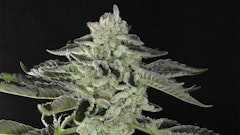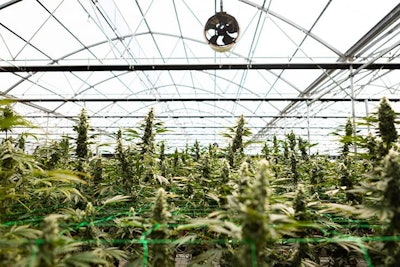
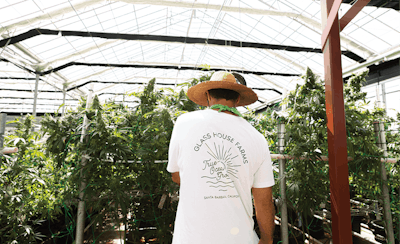
If someone had told me 10 years ago that I would be known as anything close to an “odor expert,” I would’ve never believed them. Yet here I am, spending quite a bit of my time these days learning about terpenes, not only for how they benefit the cannabis consumer, but also how they impact odor and best available technologies to control those smells. Since becoming President and Chief Cannabis Officer of Glass House Group and Glass House Farms, a leading cannabis cultivator in Santa Barbara, Calif., advancing the science of the best available odor control technology has been a major focus of our operations.
Santa Barbara County is unique because our agricultural lands are in the same valley as residential neighborhoods, which makes managing the potential smell from cannabis grows particularly important.
This proximity between farmers and residences led to Santa Barbara’s odor control ordinances, which are some of the most stringent in the state, and Glass House Group being thrown head-first into the depths of efficient odor mitigation.
Because being a good neighbor is one of our top priorities at Glass House, odor mitigation was something that we incorporated in our operations from day one, long before California implemented requirements and regulations to do so.
Through the process, I’ve swiftly learned that community outreach, advanced odor control technologies and public education are crucial initiatives in establishing cannabis businesses as responsible and respectful neighbors.
Understanding the Basics
Nothing about cannabis cultivation is dangerous or odor polluting, it just has a distinctive odor, like lemons, pine or eucalyptus trees. Some people, myself and likely many of you, love it. Others don’t—sometimes for the odor, sometimes for what it represents (although cannabis is being more accepted in our society, not everyone is there yet). Most of the aroma comes from the plant’s piney, citrusy, peppery or fruity terpenes, one of the most common compounds produced by all flowering plants.
In an area like Santa Barbara, we have both residential as well as agriculture zoning, something that gives the region its special rural vibe. That also means the odors don’t have far to travel before reaching residents.
RELATED: Santa Barbara Rules:The California County Is Working With Growers and Residents to Refine Odor Control Regulations
Odor control is handled at the county level in California, and the Santa Barbara Department of Planning & Development enforces the local odor standards. Every cannabis license applicant is required to prepare and submit an Odor Abatement Plan that covers the entire gamut of odor control, from a description of the specific odor-emitting activities that will occur to the designation of a local contact responsible for responding to odor complaints. The plan must prevent odors from being detectable in residential areas, and cannabis operators are at risk of losing their licenses if they receive too many odor complaints.
Time to Get Technical
At Glass House, odor mitigation strategies begin before any plants enter the greenhouse. The layout of a cannabis cultivation facility can influence the effectiveness of the overall odor control plan. By isolating cannabis-containing rooms from common areas and placing frequently used doors far from plant-holding areas, odors can be more easily controlled. This includes tightly insulating the building to ensure air doesn’t leak through any cracks or crevices, as well as warehouse systems that operate on negative pressure so that all air passes through carbon filters before leaving the building. It is important to remember that what is appropriate for a warehouse and what is appropriate for a greenhouse is very different.
The most consequential aspect of any strategy is the technology implemented to filter and neutralize the odors. The standard method for indoor odor control has historically been carbon filtration, and while this has proven effective in places with indoor cultivation like Denver, it’s not the best option for greenhouse operations that require large amounts of air circulation and venting.
The most effective technology for greenhouses are vapor-phase systems, which are a flexible and efficient alternative for serious odor control. Vapor molecules are small enough that they can easily float through the air and attach to terpenes more effectively. The terpenes and vapor attach to each other to create a combined molecule with a different shape. Smells are determined by the shape of the molecule that’s recognized by the nose, so by changing the shape of the terpene molecule, the odor is neutralized rather than covered up. The vapor-phase filtration system is also more eco-friendly with no water requirements or filter replacements necessary. These findings about the effectiveness of vapor-phase systems for cannabis greenhouses (and also landfills) were published in an Environmental Impact Report by the Santa Barbara Cannabis Land Use Ordinance and Licensing program in December 2017.
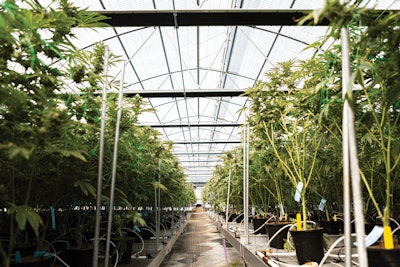
The Importance of Community Outreach
As a long-time local and active member of the Santa Barbara community, one of our top priorities at Glass House Farms is to establish and maintain friendly, productive relations with our neighbors. We have created educational videos and hired PhD climate scientists to educate locals and local government on cannabis and odor. The biggest underlying factor is removing the stigma of cannabis. By conducting continuous community outreach and offering tours of our facilities to provide transparency, we’ve been able to educate the public about the cannabis grow process and our rigorous odor mitigation techniques.
RELATED: 10 Questions With Graham Farrar, CEO of Glass House Farms
But to solve the odor issue and peacefully cohabitate with the community, every single cannabis farm in the area must be involved. Thus, in 2018 we formed Cannabis Association for Responsible Producers (CARP) Growers, a local cannabis farmers group whose mission is to foster a positive relationship with the Carpinteria community by promoting best practices among cannabis growers. When one member discovers a solution or technique that supports our initiative, they’re able to easily share it with neighboring farms for the benefit of the whole. The group enforces these best practices through bylaws that require odor mitigation strategies as well as reports that confirm each farm is running their system.
CARP Growers also is heavily involved in philanthropy and invests in the community, donating to local groups, state parks, movie theaters and more, all of which increases the goodwill with the residential community.
Going Forward
The odor issues in Santa Barbara are not yet completely resolved. There is still a small portion of the community that is upset that cannabis is present. But the situation has vastly improved compared to where we were two years ago: the science, systems, and SOPs have improved. Although it has been a challenging process, I’ve learned a lot from the experience, as well as a lot more than I ever thought I would know about odor mitigation.
Some of the lessons learned include that odors from cannabis can be a controversial issue in some communities. Cannabis is treated differently from other agriculture (think garlic farms). But we are committed to being good neighbors, for the long term, and have learned a tremendous amount about the science of odors, and best available control technologies, along the way. The odor control industry, for cannabis specifically, still is evolving rapidly, and one thing is for certain, we are committed to always being on the cutting edge of new technological advancements. And we challenge the rest of the industry to do the same.










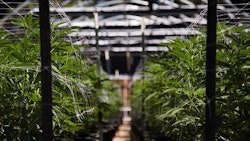
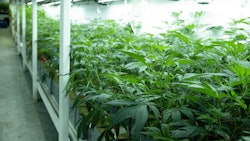
.jpg?auto=format%2Ccompress&fit=crop&h=141&q=70&w=250)







